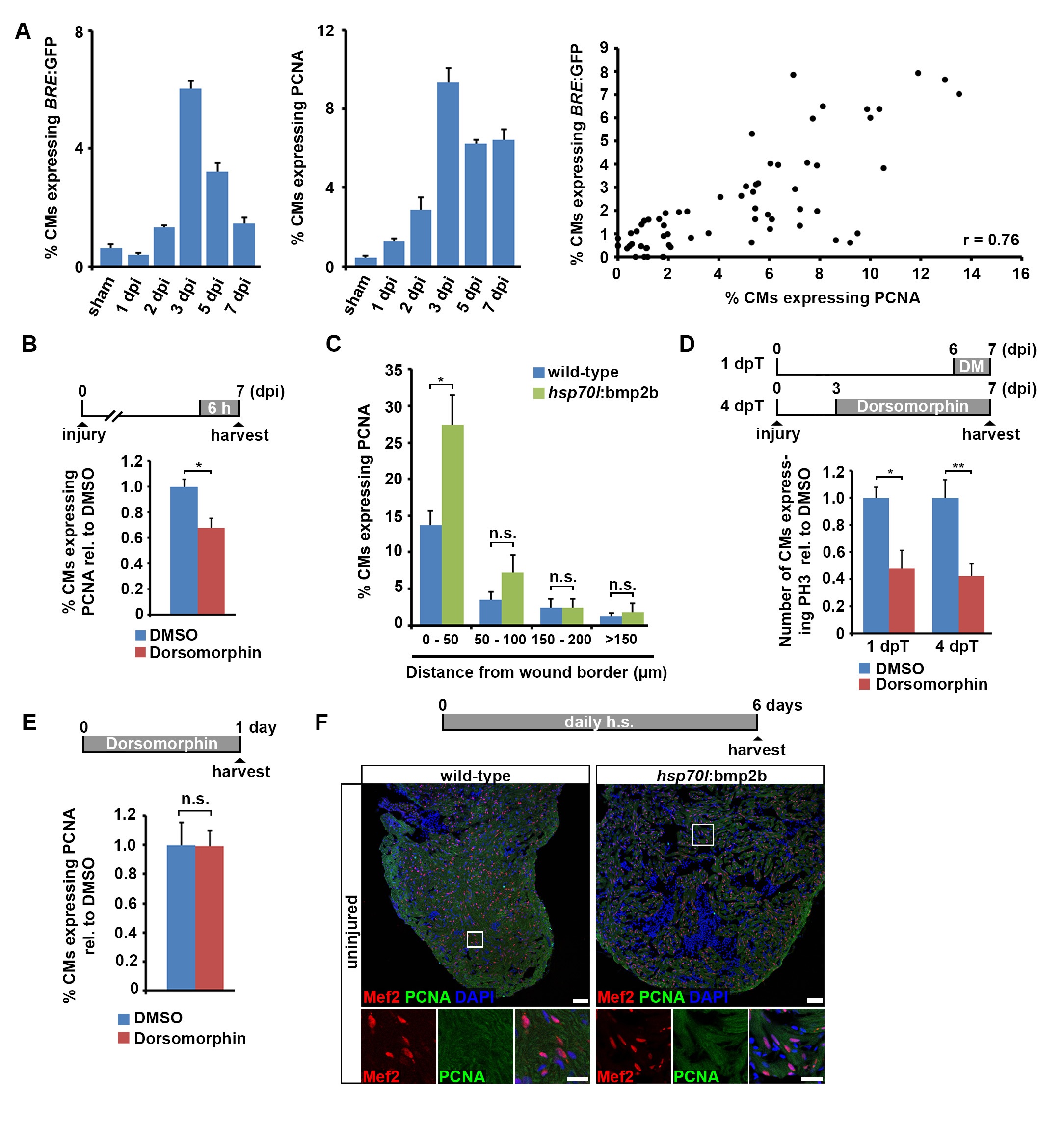Fig. S6
BMP signaling is required for cardiomyocyte cell cycle re-entry. Related to Figure 7.
(A) BMP signaling activation, as revealed by BRE:GFP expression, positively correlates with PCNA expression in cardiomyocytes. Average percentage of cardiomyocytes expressing BRE:GFP and PCNA in sham and injured hearts at 1, 2, 3, 5 and 7 dpi is plotted. Percentage of cardiomyocytes expressing BRE:GFP is then plotted against percentage of cardiomyocytes expressing PCNA to determine the Pearson′s correlation coefficient (r = 0.76). Each data point represents one analyzed section.
(B) Treatment of wild-type fish with 5 µM Dorsomorphin for 6 h reduces the expression of PCNA in cardiomyocytes at 7 dpi. Average percentage of cardiomyocytes expressing PCNA relative to DMSO control is plotted. Error bars represent SEM. Student?s t test, p = 0.015.
(C) Overexpression of bmp2b for 6 days via daily heat-shock increases the expression of PCNA in cardiomyocytes within 50 µm of the wound border, but not further away, in hsp70l:bmp2b transgenics relative to heat-shocked wild-type siblings at 7 dpi. Average percentage of cardiomyocytes expressing PCNA at different distances from the wound border is plotted. Error bars represent SEM. Student?s t test, *, p = 0.02 (0 - 50 µm), p = 0.25 (50 ? 100 µm), p = 0.98 (100 ? 150 µm), p = 0.66 (> 150µm).
(D) Treatment of myl7:GFP transgenic fish with 5 µM Dorsomorphin for 1 or 4 days reduces the number of phospho-Histone 3 (PH3)+ mitotic cardiomyocytes. Average number of cardiomyocytes expressing PH3 relative to DMSO control is plotted. Error bars represent SEM. Student?s t test, p = 0.028 (1 dpT), p = 0.0014 (4 dpT).
(E) In juvenile fish, treatment with 5 µM Dorsomorphin for 24 h does not reduce the expression of PCNA in cardiomyocytes. Average percentage of cardiomyocytes expressing PCNA relative to wildtype is plotted. Error bars represent SEM. Student?s t test, p = 0.96.
(F) Overexpression of bmp2b for 6 days via daily heat-shock is not able to induce expression of PCNA in cardiomyocytes in uninjured hsp70l:bmp2b transgenic hearts. Scale bar, 50 µm.
Reprinted from Developmental Cell, 36(1), Wu, C.C., Kruse, F., Vasudevarao, M.D., Junker, J.P., Zebrowski, D.C., Fischer, K., Noël, E.S., Grün, D., Berezikov, E., Engel, F.B., van Oudenaarden, A., Weidinger, G., Bakkers, J., Spatially Resolved Genome-wide Transcriptional Profiling Identifies BMP Signaling as Essential Regulator of Zebrafish Cardiomyocyte Regeneration, 36-49, Copyright (2016) with permission from Elsevier. Full text @ Dev. Cell

